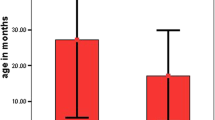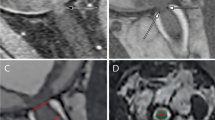Abstract
Background
Gadolinium-enhanced T1-weighted MRI without fat saturation has been recommended for assessment of retinoblastoma.
Objective
The purpose of this study was to compare diagnostic image quality without and with fat saturation following gadolinium administration.
Materials and methods
High-resolution gadolinium-enhanced T1-weighted sequences with and without fat saturation performed in children with subsequently histopathologically confirmed retinoblastoma were included. Image analysis (image quality [1 = poor, 2 = moderate, 3 = good], anatomical detail depiction, tumour extension) was performed by two neuroradiologists in consensus. Enhancement was scored and measured. Signal- and contrast-to-noise ratios were calculated. Image-assessed tumour invasiveness was compared to histopathological findings. Paired sample t-test was used for statistical analysis.
Results
Thirty-six children (mean age, 19.0 ± 16.8 [SD] months) were included. Image quality and anatomical detail depiction were significantly better without fat saturation (P < 0.001). Tumour enhancement was rated higher with fat saturation (P < 0.001). Fat saturation improved detection of (post-)laminar optic nerve infiltration. Detection of choroidal invasion was improved without fat saturation. Combining both sequences was best in the assessment of tumour extension (sensitivity/specificity for (post-)laminar optic nerve infiltration, 75.0%/100.0%, and for choroidal invasion, 87.5%/85.7%).
Conclusion
Combined T1-weighted spin-echo imaging with and without fat saturation improved the image quality for assessment of invasiveness of retinoblastoma.




Similar content being viewed by others
References
Rodriguez-Galindo C, Chantada GL, Haik BG et al (2007) Treatment of retinoblastoma: current status and future perspectives. Curr Treat Options Neurol 9:294–307
Shields CL, Shields JA (2010) Retinoblastoma management: advances in enucleation, intravenous chemoreduction, and intra-arterial chemotherapy. Curr Opin Ophthalmol 21:203–212
Barb SM, Rodriguez-Galindo C, Wilson MW et al (2011) Functional neuroimaging to characterize visual system development in children with retinoblastoma. Invest Ophthalmol Vis Sci 52:2619–2626
Narang S, Mashayekhi A, Rudich D et al (2012) Predictors of long-term visual outcome after chemoreduction for management of intraocular retinoblastoma. Clin Exp Ophthalmol 40:736–742
Suzuki S, Yamane T, Mohri M et al (2011) Selective ophthalmic arterial injection therapy for intraocular retinoblastoma: the long-term prognosis. Ophthalmology 118:2081–2087
Shields CL, Palamar M, Sharma P et al (2009) Retinoblastoma regression patterns following chemoreduction and adjuvant therapy in 557 tumors. Arch Ophthalmol 127:282–290
Shields CL, Ramasubramanian A, Thangappan A et al (2009) Chemoreduction for group E retinoblastoma: comparison of chemoreduction alone versus chemoreduction plus low-dose external radiotherapy in 76 eyes. Ophthalmology 116:544–551
de Graaf P, Barkhof F, Moll AC et al (2005) Retinoblastoma: MR imaging parameters in detection of tumor extent. Radiology 235:197–207
Rubin CM, Robison LL, Cameron JD et al (1985) Intraocular retinoblastoma group V: an analysis of prognostic factors. J Clin Oncol 3:680–685
Eagle RC Jr (2009) High-risk features and tumor differentiation in retinoblastoma: a retrospective histopathologic study. Arch Pathol Lab Med 133:1203–1209
Khelfaoui F, Validire P, Auperin A et al (1996) Histopathologic risk factors in retinoblastoma: a retrospective study of 172 patients treated in a single institution. Cancer 77:1206–1213
Kim CJ, Chi JG, Choi HS et al (1999) Proliferation not apoptosis as a prognostic indicator in retinoblastoma. Virchows Arch 434:301–305
Chong EM, Coffee RE, Chintagumpala M et al (2006) Extensively necrotic retinoblastoma is associated with high-risk prognostic factors. Arch Pathol Lab Med 130:1669–1672
Kaliki S, Shields CL, Shah SU et al (2011) Postenucleation adjuvant chemotherapy with vincristine, etoposide, and carboplatin for the treatment of high-risk retinoblastoma. Arch Ophthalmol 129:1422–1427
Lemke AJ, Kazi I, Mergner U et al (2007) Retinoblastoma—MR appearance using a surface coil in comparison with histopathological results. Eur Radiol 17:49–60
Brisse HJ, Guesmi M, Aerts I et al (2007) Relevance of CT and MRI in retinoblastoma for the diagnosis of postlaminar invasion with normal-size optic nerve: a retrospective study of 150 patients with histological comparison. Pediatr Radiol 37:649–656
Gizewski ER, Wanke I, Jurklies C et al (2005) T1 Gd-enhanced compared with CISS sequences in retinoblastoma: superiority of T1 sequences in evaluation of tumour extension. Neuroradiology 47:56–61
de Graaf P, Goricke S, Rodjan F et al (2012) Guidelines for imaging retinoblastoma: imaging principles and MRI standardization. Pediatr Radiol 42:2–14
Schueler AO, Hosten N, Bechrakis NE et al (2003) High resolution magnetic resonance imaging of retinoblastoma. Br J Ophthalmol 87:330–335
Al-Saeed O, Ismail M, Athyal R et al (2011) Fat-saturated post gadolinium T1 imaging of the brain in multiple sclerosis. Acta Radiol 52:570–574
Sardanelli F, Schiavoni S, Iozzelli A et al (2007) The value of chemical fat saturation pulse added to T1-weighted spin-echo sequence in evaluating gadolinium-enhancing brain lesions in multiple sclerosis. Radiol Med 112:1244–1251
Chawla B, Sharma S, Sen S et al (2012) Correlation between clinical features, magnetic resonance imaging, and histopathologic findings in retinoblastoma: a prospective study. Ophthalmology 119:850–856
Wilson MW, Rodriguez-Galindo C, Billups C et al (2009) Lack of correlation between the histologic and magnetic resonance imaging results of optic nerve involvement in eyes primarily enucleated for retinoblastoma. Ophthalmology 116:1558–1563
Rauschecker AM, Patel CV, Yeom KW et al (2012) High-resolution MR imaging of the orbit in patients with retinoblastoma. Radiographics 32:1307–1326
Author information
Authors and Affiliations
Corresponding author
Rights and permissions
About this article
Cite this article
Sirin, S., Schlamann, M., Metz, K.A. et al. Diagnostic image quality of gadolinium-enhanced T1-weighted MRI with and without fat saturation in children with retinoblastoma. Pediatr Radiol 43, 716–724 (2013). https://doi.org/10.1007/s00247-012-2576-y
Received:
Revised:
Accepted:
Published:
Issue Date:
DOI: https://doi.org/10.1007/s00247-012-2576-y




